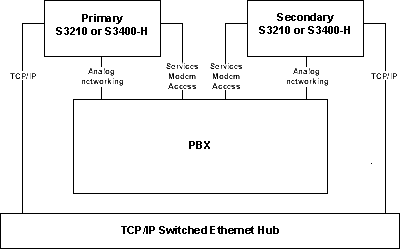|
Message Networking Release 2.0 supports an attended high-availability
option, which is intended for extreme disaster recovery circumstances
when an operational Message Networking that cannot perform normal
operations due to unscheduled downtime.
The high-availability option is supported for the S3210, S3210R and
S3400-H servers. The S3400-H server provides additional reliability
and availability features, including:
- RAID Level 5 disks (redundant and hot-swappable)
- Redundant and hot-swappable power supply
- Redundant and hot-swappable fans
- Required Uninterruptible Power Supply (UPS)
In the Attended High Availability Option scenario, a colocated,
dedicated, spare server (referred to as the Secondary
Message Networking application) is required for each live Message
Networking application (known as the Primary Message Networking
application). The server and software
(Avaya Message Networking software) configuration of the Secondary
Message Networking application must be exactly the same as that
of the live Message Networking application for which it is backing
up. The primary and secondary servers must be of the same type;
this is, if the primary Message Networking server is an S3210, then
the secondary must also be an S3210. If the primary Message Networking
server is an S3400-H, then the secondary must be an S3400-H.
Note: If you do not want the secondary server
to be colocated with the primary, then it must at least be on the
same IP subnet as the primary. This is required so that the secondary
can assume the same IP address as the primary system if it is down.
In addition, if analog connectivity is required, then the switch
providing that connectivity must be programmable such that it can
forward those analog calls to the ports on the secondary system.
These requirements are necessary to alleviate the re-administration
of the remote message servers when accessing the primary or secondary
systems.
The following figure provides a graphical depiction of the high-availability
option.

There are two connectivity options for the Secondary Message Networking
application:
Option 1: Connected” Secondary Message Networking:
- LAN connectivity:
- TCP/IP connected to the LAN.
- IP Address of Secondary Message Networking configured to
not conflict with Primary Message Networking during normal
day-to-day operations.
- Switch connectivity:
- Analog Networking Ports connected to the switch.
- Services Modem connected to analog switch port (if alarms
are not problem).
- Switch translations for all port types such that incoming
calls do not occur until disaster recovery procedures are
in place.
Option 2: Disconnected Secondary Message Networking:
- LAN Connectivity
- TCP/IP not connected to the LAN
- IP Address of Secondary Message Networking configured to
be equal to the Primary Message Networking
- Switch Connectivity
- Analog Networking Ports not connected to switch.
- Services Modem not connected to analog switch port.
Note: It is possible to configure the Disconnected
Secondary Message Networking (using A/B switches for example) so
that it would be much faster to put into service and less error
prone than the Connected Secondary Option.
Please note the following considerations regarding the attended
high-availability option:
- The estimated down time is approximately 2 hours.
- Voice names are not restored unless an Attended Backup of the
Primary Message Networking is executed.
- Messages/Status Messages/Remote Updates in queue on the Primary
Message Networking when it goes down are lost.
There are administration procedures
required to support the high-availability option daily, as well
as procedures you must follow if you must put the secondary Message
Networking into services.
Top of page
|

